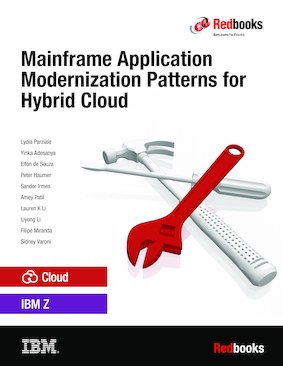
Published on 27 June 2023, updated 30 June 2023
Share this page:
ISBN-10: 0738461016
ISBN-13: 9780738461014
IBM Form #: SG24-8532-00
Authors: Lydia Parziale, Yinka Adesanya, Elton de Souza, Peter Haumer, Sandor Irmes, Amey Patil, Lauren K Li, Liyong Li, Filipe Miranda and Sidney Varoni
Abstract
As businesses digitally transform, they can impose significant demands on existing mainframe applications and data requiring the need to modernize to achieve business outcomes.
To meet this need for modernization which includes greater agility, efficiency, and innovation, they are choosing a hybrid cloud strategy that brings together the best of IBM Z® and Cloud.
IBM Z integrated into a hybrid cloud based on Red Hat OpenShift provides resiliency and secure architecture that allows for application workload placement on the "best fit" infrastructure to maximize scale, performance, and efficiency. You can accelerate application modernization today by using architectural patterns that are building blocks and best practices to learn how to implement and deploy application modernization in an IBM Z environment integrated with public cloud.
In the IBM Redpaper Accelerate Mainframe Application Modernization with Hybrid Cloud, REDP-5705, we discussed strategies and architectural solutions that can accelerate your mainframe application modernization by leveraging hybrid cloud environments.
This IBM Redpaper publication takes that IBM Redpaper on a deeper dive as it discusses and demonstrates implementation approaches to modernization when adopting a hybrid cloud with IBM Z. We discuss and demonstrate application centric, data integration/access centric, and event driven modernization patterns.
Additionally, we provide a chapter on modernizing an enterprise's DevOps with patterns and a chapter on managing your applications.
Finally, we conclude with a demonstration of deployments of production applications.
This IBM Redbooks® publication provides information for IT Architects, IT Specialists and system administrators.
Table of Contents
Chapter 1. Introduction
Chapter 2. Modernized application architectures
Chapter 3. Modernized data access architectures
Chapter 4. Event-driven architecture with IBM z/OS
Chapter 5. Modernizing Enterprise DevOps
Chapter 6. Managing your applications
Chapter 7. Deploying production applications
Appendix A. Voting app changes to support an IBM Db2 database
Appendix B. Additional material